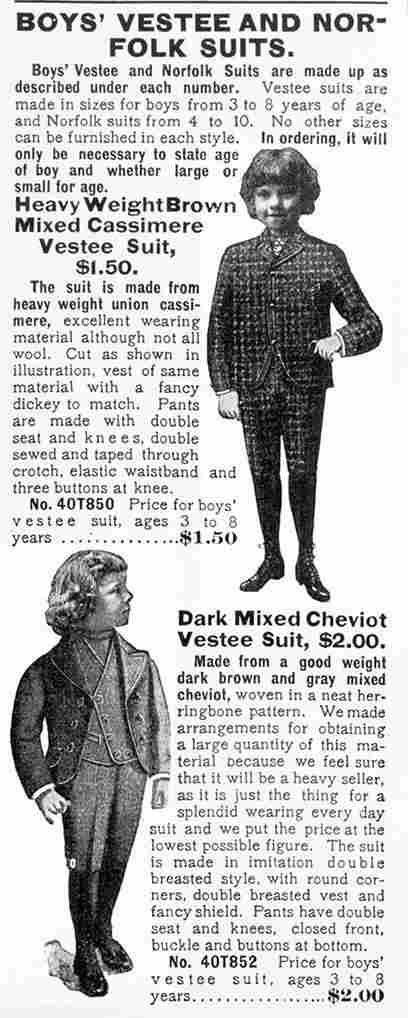
Sears Vestee and Norfolk Suits (1902)

Figure 1.--Sears offered vestee and Norfolk suits in 1902. I'm not sure precisely what a vestee suit meant. Presumably vestee means that it had a vest (waistcoat), but we note that one suit has a dickey rather than a vest. The Norfolk suits (not shown) were done in sizes 4-10 years.
|
We note both single and double breasted styles. Sears offered vestee and Norfolk suits in 1902. A vestee suit was a suit that had a matching or coordinated vest (waistcoat). One vestee suit had a dickey in addition to a vest. The vestee suits were done in sizes 3-8 years. The Norfolk suit was done in sizes 4-10. Cheviot was a popular fabric as was cassimere. Brown seems to have bee as especially popular color.
The Sears, Roebuck and Co., huge merchandising firm centered in Chicago was
founded by Richard W. Sears (1863-1914) and A.C. Roebuck (1864-1948). Sears had begun a career in mail-order business in Minnesota 1886. In Chicago he and Roebuck joined resources and formed a corporation in 1893 as a mail-order business under title Sears, Roebuck and Company. In 1895 Julius Rosenwald (1862-1932) bought Roebuck's interest in firm and became president on Sears's retirement 1908. A retail-store system was added 1925. The first foreign store added in Havana, Cuba
during 1945 and becane the first expropriated store in 1960. The Sears-Roebuck brought the production of industry to the fartherest corner of rural America, opening the cornucopia of the consumer age to rural America. All the new
things that were changing American life danced across their pages. Through it, a huge Chicago warehouse offers to modernize the farms and small towns of the Midwest.
Vestee Suits
Sears meant by vestee suit, a suit with a matching or coordinated vest (waistcoat). The styling is notably different than that offered for boys 8 and older. The vestee suits were done in sizes 3-8 years. Here Sears offers two different vestee suits. Note that both suits here are done in brown which seems to have been a partivcularly popular color for suits. We note both single and double breasted styles.
Heavy weight Brown mixed cassimere vestee suit
Sears called this suit a vestee suit. It not only has a vest, but a dickey as well. We are not sure about what "union cassimere" meant. Today Cashmere is very expensive fabric. We are unsure if the term cassimere was chosen to soundlike cashmere or if this was an alternative spelling at the time. Note that Sears says that it is not all wool, unfortunately we do not yet have details on just what "union cassimere" was. Cassimere is no longer a commonly used term. Notably the cassimere suit is less expensive than the cheviot suit below. The ad copy read, "The suit is made from heavy weight union cassimere, excellent wearing material although not all wool. Cut as shown in the illustration, vest of the same material with a fancy dickey to match. Pants are made with double seat and knees, double sewed and taped through crotch, elassic waistband and three buttons at knee. No. 40T850 Price for boys' vestee suits, age 3 to 8 years ..... $1.50."
Dark mixed cheviot vestee suit
Here the term mixed appears torefer to a pattern mixing brown and grey. Cheviot was a popular wool fabric. The ad copy reads, "Made with a good weight dark brown and gray mixed cheviot, woven in a neat herringbone pattern. We mase arrangements for obtaining a large quantity of this material because we feel sure that it will be a heavy seller, as it is just the thing for a splendid wearing every day suit and we put the price at the lowest possible figure. The suit is made in imitation double breasted style with rounded corners, double breasted vest and fancy shield [dickey]. Pants have double seat and knee, closed front, buckle and buttons at bottom. No. 40T852 Price for boys' vestee suits, age 3 to 8 years ..... $2.00."
Norfolk Suits
We do not yet have information on Sears Norfolk suits for younger boys, except that they were done in sizes 4-10 years.
Everyday Suit
Notice the use by Seas of the term "ever day suit". This reflects the fact that boys in 1902, at least boys from urban families normally wore suits for everyday. This includes even boy from working class families. Note the many photographs of newsboys beforeWorld War I. They often are seen wearing suits, evcen though threy may be barefoot.
Note that one of the suits had an elasic waistband. It was common at the time to use button-on styles to help a boy keep his pants up. The button arrangements were also employed to keep long stockings up. Elastic began to be used in clothig during the early 19th century. Thomas Hancock in 1820 obtained a patent for elastic
fastenings. He used them for for gloves, suspenders, shoes, and stockings. Even so we do not notice it commonly being used for waistbands as is the case todat. We are not sure why this was. Cost may be a factor.
Age Grouping
Notice the age grouping here , 3-8 and 4-10 years. Age groupings seem more flexible than today and often specific styles are more likely to have specufic age ranges than today. Also in 1902, school age (about 6) and teen ages (abouut 12) are less likely to be the beginning of age appropriate style style changes.
HBC

Navigate the Boys' Historical Clothing catalog/magazine pages:
[Return to the Main 1902 suit page]
[Main photo/publishing page]
[Store catalogs]
[Fashion magazines]
Navigate the Boys' Historical Clothing Web Site:
[Introduction]
[Activities]
[Biographies]
[Chronology]
[Cloth and textiles]
[Clothing styles]
[Countries]
[Topics]
[Bibliographies]
[Contributions]
[FAQs]
[Glossaries]
[Satellite sites]
[Tools]
[Boys' Clothing Home]
Navigate the Boys' Historical Clothing Web Site:
[Sailor suits]
[Sailor hats]
[Buster Brown suits]
[Eton suits]
[Rompers]
[Tunics]
[Smocks]
[Vests]
[Norfolk]
[Kneepants]
[Dickeys]
[Cassimere]
[Cheviot]
[Herringbone]
Created: 9:21 PM 8/27/2004
Last updated: 7:00 AM 8/28/2004



